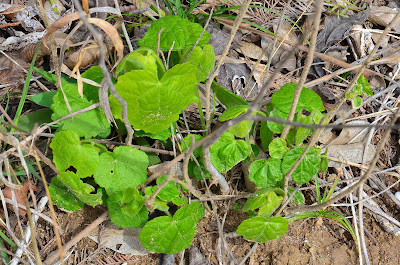 |
| Agarita |
This past week, James and I visited the Canyon Lake area on a magazine assignment. Naturally, I paused here and there to photograph plants and critters. Above, I spotted this beautiful leaf on an agarita at Overlook Park at Canyon Dam above the spillway. Some plants I could identify; others I couldn't. Some are perennials putting out new growth.
 |
| Evergreen sumac (Overlook Park) |
 |
| Texas thistle (Cirsium texanum), photographed at Canyon Lakeview Resort. |
 | ||||
| Mullein (Verbascum thapsus), a nonnative that's naturalized across Texas. Photographed at Canyon Lakeview Resort. |
 |
| Lindheimer's senna (Senna lindheimeriana)–The long, dark brown seed pods are barely visible from the old-growth stem. Photographed at Canyon Lakeview Resort. |
 |
| Black-eyed susans (Rudbeckia hirta) ???? ...This plant and the rest that follow were photographed at the Guadalupe River South Trail below Canyon Dam. |
 |
| Inland sea oats (Chasmanthium latifolium) |
 |
| Coneflower (Echinacea purpurea) ?? |
 |
| Soft-hair marbleseed (Onosmodium bejariense var. bejariense) A BIG THANK YOU to Edie Zaiontz, a Texas Master Naturalist, for identifying this species! |
 |
| Turk's cap...we have lots of these growing in our Wildscape. |
 |
| Help! |
 |
| Soft-hair marbleseed (Onosmodium bejariense var. bejariense) |
 |
| Engelmann's daisy (Engelmannia peristenia) but more likely a Plains coreopsis (Coreopsis tinctoria Nutt.) |

4 comments:
I think your "echinacea" is an aster, And your "rudbeckia" looks like Silphium.
"Help"... a plantain, maybe? 2nd help possibly an artemisia?
I'm not sure about the "prickly poppy" either. I think thistle is more likely... But... I could totally grow some prickly poppy in my sand-hill garden.
Were you allowed to bring any of these back your home garden? I think I'd be 'accidentally' leaving with some seedheads...
Wow, you're fast! I've got a "call" into a Master Naturalist from that area, and I'm hoping she can help with the IDs. In the meantime, thank YOU. I'll be curious to see what everyone thinks.
Your First Help is: False Gromwell that is indigenous to Spring Branch and now Canyon Lake. See below. You can verify on LBJ Wildflower Website. Have it in my yard. I live in Spring Branch. Probably is the same as the 2nd photo, but not sure, need a close up.
Onosmodium bejariense var. bejariense DC. ex A. DC.
Soft-hair marbleseed, False Gromwell
Boraginaceae (Borage Family)
USDA Symbol: ONBEB
USDA Native Status: Native to U.S.
I don't think your last one is Engelmann's Daisy, the leaves serrate, but aren't so separate as these. Most likely the yellow coreopsis or Tickseed. Coreopsis tinctoria Nutt.
Plains coreopsis, Golden tickseed, Goldenwave, Calliopsis
Asteraceae (Aster Family)
Synonyms: Coreopsis tinctoria var. tinctoria, Coreopsis cardaminefolia
USDA Symbol: COTI3
USDA Native Status: Native to U.S.
The last "help" I have in my yard, but I don't have my wildflower book with me to compare. If you don't need the name til the 21st I will look at home and get back with you.
Thank you for the IDs! That false gromwell looks cool in bloom!
Post a Comment